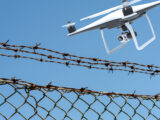ABSI CEO, Chris Sacco, talks about why you can’t just “shoot down” a drone

In a recent article in Security Magazine (available here), CEO of ABSI, Chris Sacco, talks about the legal implications of shooting down or disabling a drone, an issue that bounds one in lots of regulatory red tape and is about as clear as murky water.
As Sacco notes in the article, “The FAA considers unmanned aircraft of any size to be covered under Title 18 of the United States Code 32, which describes “sabotage to include destruction of any aircraft in the special aircraft jurisdiction of the United States.” Violation of this code carries a maximum prison sentence of 20 years. In other words, it’s illegal to shoot down any aircraft in the U.S., including a drone, according to federal law. And lest you decide that simply jamming or intercepting control of the offending drone might be more your style, know that the FCC considers any form of “jamming” or otherwise interfering with radio transmission to be a violation of the Communications Act of 1934. Between these two federal laws, most anti-drone technology on the market (including net guns and jamming guns) could put you into some legal hot water.”
In the piece, Sacco outlines five steps to help combat unwanted intrusions from unidentified and possibly malicious drones, focusing especially on law enforcement and other first responders. As the Managing Partner for RedUAS, a company that provides Counter-UAS services and consulting, Sacco is an authority in this rapidly evolving area.
“Because regulations are evolving and differ by locality, take the time to learn what laws apply in your specific locale. Until regulations catch up with UAS technology, providing security that includes a counter-drone plan can feel a little like policing the wild west. Smart planning and partnership with the right counter-UAS partners or technologies for you can keep your property and people safe,” Sacco concludes.




